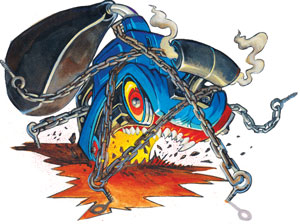We may receive a commission when you use our affiliate links. However, this does not impact our recommendations.

Tame Your Belt Sander
Tips to help you gain confidence and get goof-proof results.
By George Vondriska
Does the prospect of using a belt sander make your palms sweat and your
hands shake? I feel your pain. Belt sanders have a bad rap as the
quickest way to ruin a project. Use them incorrectly and your project
starts to look like the rolling hills of Ireland. But used correctly,
they're a great tool for flattening panels, flushing up trim and face
frames and getting to the finish line fast. Start by learning the
belt-sander rules of the road:
• Keep it moving. The slightest pause can form a gouge.
• Let the weight of the sander to the work. Don't lean on the machine.
• Use nothing but 120-grit paper until you're comfortable with the machine.
• Don't overextend yourself. Running a belt sander at your reach's extreme end is a sure way to gouge material.
|
1. Start with a soft landing. Before you pull the |
|
|
2. Go over the edge, but only a little. As you sand to an edge, allow the platen to project over the corner, but never by more than half its length or width. This keeps the sander balanced and flat.
|
|
|
3. End with a smooth take-off. OK, you've |
|
Setting Up
A big part of the battle is won just by taking the time to set up properly.
|
Get the height right. The surface you're sanding should |
|
|
Provide solid stops. You can't sand a piece that you're |
|
Trueing Up
A belt sander can flatten a glued-up panel in no time.
|
1. Sand diagonally first. Flatten a solid wood |
|
|
2. Then go straight. When the panel is flat, sand |
|
Tooling Up
It's a poor craftsperson who blames the tool, but it's hard to get
good results from a prehistoric belt sander. Here's what to look for in
a new belt sander.
|
Eliminate gouging with a sanding frame. A sanding frame ($50 to $80) is like training wheels for a belt sander. Unlike training wheels, you'll never want to remove the sanding frame. A slick surface on the bottom of the frame rides on your material, and the sander is suspended within the frame. This is a no-experience-required way to keep the sander under control and dead flat. Some frames even have micro-adjust knobs that allow you to control how much material the sander is taking off. Frames really shine when you're working on large surfaces. Not every belt sander is made to work with a frame, so if you're buying new, it's a feature to look for.
|
|
|
Clean belts = better results. An abrasive cleaning stick, epoxied to a |
|
|
Variable speed gives you better control. A belt sander set on low speed |
|
|
Get the right belt. Look for no-lap belts for your sander. The seam is |
|
Here are some supplies and tools we find essential in our everyday work around the shop. We may receive a commission from sales referred by our links; however, we have carefully selected these products for their usefulness and quality.



















